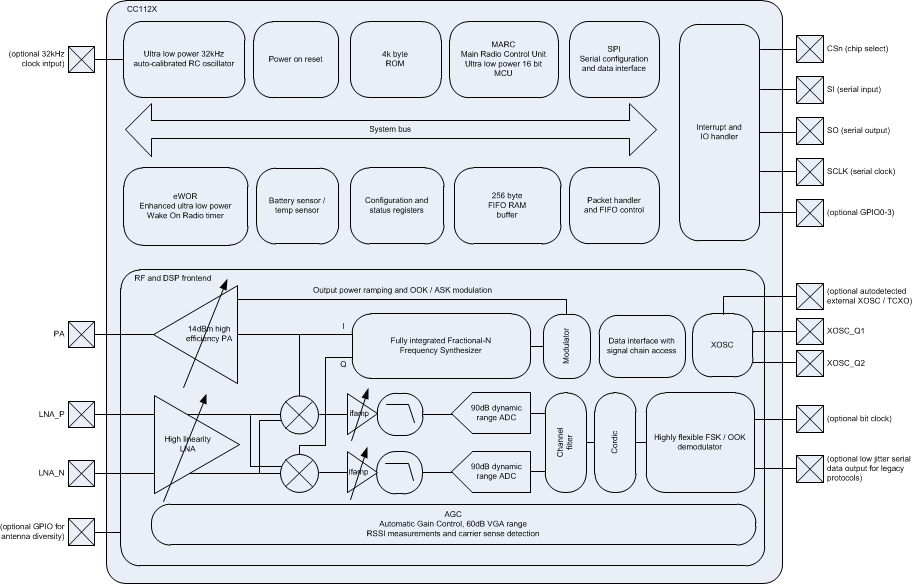SWRS112H June 2011 – July 2015 CC1120
PRODUCTION DATA.
- 1Device Overview
- 2Revision History
- 3Terminal Configuration and Functions
-
4Specifications
- 4.1 ESD Ratings
- 4.2 Recommended Operating Conditions (General Characteristics)
- 4.3 RF Characteristics
- 4.4 Power Consumption Summary
- 4.5 Receive Parameters
- 4.6 Transmit Parameters
- 4.7 PLL Parameters
- 4.8 32-MHz Clock Input (TCXO)
- 4.9 32-MHz Crystal Oscillator
- 4.10 32-kHz Clock Input
- 4.11 32-kHz RC Oscillator
- 4.12 I/O and Reset
- 4.13 Temperature Sensor
- 4.14 Thermal Resistance Characteristics for RHB Package
- 4.15 Timing Requirements
- 4.16 Regulatory Standards
- 4.17 Typical Characteristics
- 5Detailed Description
- 6Application, Implementation, and Layout
- 7Device and Documentation Support
- 8Mechanical Packaging and Orderable Information
Package Options
Mechanical Data (Package|Pins)
- RHB|32
Thermal pad, mechanical data (Package|Pins)
- RHB|32
Orderable Information
1 Device Overview
1.1 Features
- High-Performance, Single-Chip Transceiver
- Adjacent Channel Selectivity:
64 dB at 12.5-kHz Offset - Blocking Performance: 91 dB at 10 MHz
- Excellent Receiver Sensitivity:
- –123 dBm at 1.2 kbps
- –110 dBm at 50 kbps
- –127 dBm Using Built-in Coding Gain
- Very Low Phase Noise:
–111 dBc/Hz at 10-kHz Offset
- Adjacent Channel Selectivity:
- Suitable for Systems Targeting ETSI Category 1 Compliance in 169-MHz and 433-MHz Bands
- High Spectral Efficiency (9.6 kbps in 12.5-kHz Channel in Compliance With FCC Narrowbanding Mandate)
- Separate 128-Byte RX and TX FIFOs
- Support for Seamless Integration With the CC1190 Device for Increased Range Giving up to 3-dB Improvement in Sensitivity and up to +27-dBm Output Power
- Power Supply
- Wide Supply Voltage Range (2.0 V to 3.6 V)
- Low Current Consumption:
- RX: 2 mA in RX Sniff Mode
- RX: 17 mA Peak Current in Low-Power Mode
- RX: 22 mA Peak Current in
High-Performance Mode - TX: 45 mA at +14 dBm
- Power Down: 0.12 μA
(0.5 μA With eWOR Timer Running)
- Programmable Output Power up to +16 dBm With 0.4-dB Step Size
- Automatic Output Power Ramping
- Configurable Data Rates: 0 to 200 kbps
- Supported Modulation Formats: 2-FSK,
2-GFSK, 4-FSK, 4-GFSK, MSK, OOK - WaveMatch: Advanced Digital Signal Processing for Improved Sync Detect Performance
- RoHS-Compliant 5-mm × 5-mm No-Lead QFN
32-Pin Package (RHB) - Regulations – Suitable for Systems Targeting Compliance With
- Europe: ETSI EN 300 220, ETSI EN 54-25
- US: FCC CFR47 Part 15, FCC CFR47 Part 90, 24, and 101
- Japan: ARIB RCR STD-T30, ARIB STD-T67, ARIB STD-T108
- Peripherals and Support Functions
- Enhanced Wake-On-Radio (eWOR) Functionality for Automatic Low-Power Receive Polling
- Includes Functions for Antenna Diversity Support
- Support for Retransmissions
- Support for Automatic Acknowledge of Received Packets
- TCXO Support and Control, Also in Power Modes
- Automatic Clear Channel Assessment (CCA) for Listen-Before-Talk (LBT) Systems
- Built-in Coding Gain Support for Increased Range and Robustness
- Digital RSSI Measurement
- Temperature Sensor
1.2 Applications
- Narrowband Ultra-Low-Power Wireless Systems With Channel Spacing Down to
12.5 kHz - 169-, 315-, 433-, 868-, 915-, 920-, 950-MHz ISM/SRD Band
- Wireless Metering and Wireless Smart Grid
(AMR and AMI) - IEEE 802.15.4g Systems
- Home and Building Automation
- Wireless Alarm and Security Systems
- Industrial Monitoring and Control
- Wireless Healthcare Applications
- Wireless Sensor Networks and Active RFID
- Private Mobile Radios
1.3 Description
The CC1120 device is a fully integrated single-chip radio transceiver designed for high performance at very low-power and low-voltage operation in cost-effective wireless systems. All filters are integrated, thus removing the need for costly external SAW and IF filters. The device is mainly intended for Industrial, Scientific, and Medical (ISM) applications and Short Range Device (SRD) frequency bands at
164 to 192 MHz, 274 to 320 MHz, 410 to 480 MHz, and 820 to 960 MHz.
The CC1120 device provides extensive hardware support for packet handling, data buffering, burst transmissions, clear channel assessment, link quality indication, and wake-on-radio. The main operating parameters of the CC1120 device can be controlled through an SPI interface. In a typical system, the CC1120 device is used with a microcontroller and only a few external passive components.
1.4 Functional Block Diagram
Figure 1-1 shows the system block diagram of the CC1120 device.
 Figure 1-1 Functional Block Diagram
Figure 1-1 Functional Block Diagram